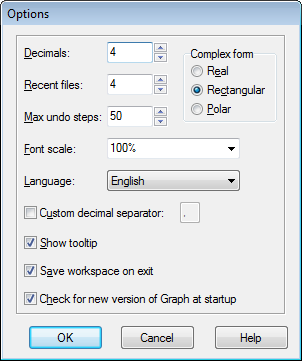When you choose the menu item → the dialog shown below will appear. In this dialog, you can change general program options.

- Decimals
This is the number of decimals that all results are shown with. The number has no influence on the calculations or the shown graphs.
- Recent files
This is the maximum number of recent used files that is shown in the menu. The number must be between 0 and 9. 0 means that no recent used files are shown.
- Max undo steps
Each time you make a change, the program will save enough information to undo it. As default Max undo steps are 50, which mean that you are able to undo the last 50 changes you made in the program. The undo steps will take up a small amount of memory. If your system is low on RAM, you may be able to free some memory by decreasing the Max undo steps.
- Font scale
You can use this to change the scale of the fonts and most of the user interface. This is mostly useful if your screen resolution is very high, or for some other reason, you are having difficulties reading the user interface.
- Language
This shows a list of available languages for the program. The selected language will be the one used by the program in the future. The language can be selected differently for each user.
- Custom decimal separator
Decimal separator used when data are exported to files and the clipboard. When disabled the decimal separator from the Windows Regional settings is used. This is not used for expressions entered into Graph, which always use a dot as decimal separator.
- Show tooltip
When there is a mark in this field, you will see a small box with an explanation when you are holding the mouse pointer over an object, like an edit field, selection box, etc., for a few seconds. The description is also shown in the status bar at the bottom of the main window.
- Save workspace on exit
When there is a mark in this field, Graph will save the size of the main window before it quits. The next time you start the program the saved size will be used. In addition the width of the function list is also stored. When the field doesn't have a mark the options that were last saved will be used.
- Complex form
Choose how you want a complex number to be shown in the Evaluate frame. Real means that only real numbers are shown. If a number has an imaginary part then the number won't be shown and instead you get an error. Rectangular means that complex numbers are shown as a+bi, where a is the real part and b is the imaginary part. Polar means that numbers are shown as a∠θ, where a is the absolute value of the number and θ is the angle of the number. θ is dependent of the choice between Radian and Degree under Trigonometry in the Edit axes dialog.
Notice that in some cases you may get a different result in the Evaluate frame depending on the Complex form setting: When Real is chosen, Graph will try to find a real result if possible, while Rectangular and Polar may give a non-real result for the same evaluation.
- Check for new version of Graph at startup
When checked each time the program starts it will check if a newer version of Graph is available on the Internet. If a new version is found you will be asked if you want to visit the web site for Graph to upgrade. If no new version is available you will not see any messages. If disabled, you can still use → → to see if a new version is available.